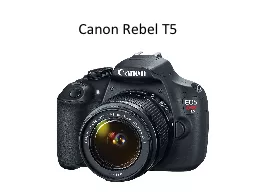PPT-Canon Rebel T5
Author : lindy-dunigan | Published Date : 2018-01-23
For shooting video the T5 needs a large capacity SD SDHC or SDXC card that is Class 6 or higher A fast write speed is needed Be sure the cards writeprotect switch
Presentation Embed Code
Download Presentation
Download Presentation The PPT/PDF document "Canon Rebel T5" is the property of its rightful owner. Permission is granted to download and print the materials on this website for personal, non-commercial use only, and to display it on your personal computer provided you do not modify the materials and that you retain all copyright notices contained in the materials. By downloading content from our website, you accept the terms of this agreement.
Canon Rebel T5: Transcript
Download Rules Of Document
"Canon Rebel T5"The content belongs to its owner. You may download and print it for personal use, without modification, and keep all copyright notices. By downloading, you agree to these terms.
Related Documents














